Cooperative Frequency Control of a Small-Scale Power System between Diesel Engine Driven Adjustable Speed Generator and Battery
Abstract
:1. Introduction
2. Overview of the System and Its Modeling
2.1. Topology of the Small-Scale Power System
2.2. Model of the Diesel Engine Driven Power Plant
2.3. Model of Battery Energy Storage System (BESS)
2.4. Model of the Wind Power Station
3. Active Power Control of the ASG to Suppress Frequency Fluctuation
4. Cooperative Control of BESS
5. Simulation Analysis
5.1. Simulation Settings
5.2. Simulation Results 1—Effect of the ASG Installation
5.3. Simulation Results 2—Effect of the Additional BESS Assisting
6. Conclusions
Author Contributions
Funding
Conflicts of Interest
References
- Yu, W.; Li, S.; Zhu, Y.; Yang, C.-F. Management and Distribution Strategies for Dynamic Power in a Ship’s Micro-Grid System Based on Photovoltaic Cell, Diesel Generator, and Lithium Battery. Energies 2019, 12, 4505. [Google Scholar] [CrossRef] [Green Version]
- Belila, A.; Benbouzid, M.; Berkouk, E.; Amirat, Y. On Energy Management Control of a PV-Diesel-ESS Based Microgrid in a Stand-Alone Context. Energies 2018, 11, 2164. [Google Scholar] [CrossRef] [Green Version]
- Worku, M.Y.; Hassan, M.A.; Abido, M.A. Real Time Energy Management and Control of Renewable Energy based Microgrid in Grid Connected and Island Modes. Energies 2019, 12, 276. [Google Scholar] [CrossRef] [Green Version]
- Moon, H.-J.; Kim, Y.-J.; Chang, J.-W.; Moon, S. Decentralised Active Power Control Strategy for Real-Time Power Balance in an Isolated Microgrid with an Energy Storage System and Diesel Generators. Energies 2019, 12, 511. [Google Scholar] [CrossRef] [Green Version]
- Chang, J.-W.; Lee, G.-S.; Moon, H.-J.; Glick, M.B.; Moon, S.-I. Coordinated Frequency and State-of-Charge Control with Multi-Battery Energy Storage Systems and Diesel Generators in an Isolated Microgrid. Energies 2019, 12, 1614. [Google Scholar] [CrossRef] [Green Version]
- Wu, Y.-K.; Tang, K.-T.; Lin, Z.K.; Tan, W.-S. Flexible Power System Defense Strategies in an Isolated Microgrid System with High Renewable Power Generation. Appl. Sci. 2020, 10, 3184. [Google Scholar] [CrossRef]
- Sebastián, R.; Pena-Alzola, R. Flywheel Energy Storage and Dump Load to Control the Active Power Excess in a Wind Diesel Power System. Energies 2020, 13, 2029. [Google Scholar] [CrossRef] [Green Version]
- Sakamoto, O.; Yamashita, K.; Kitauchi, Y.; Nanahara, T.; Inoue, T.; Arakaki, T.; Fukuda, H. Improvement of a voltage-stabilizing control system for integration of wind power generation into a small island power system. In Proceedings of the 2011 2nd IEEE PES International Conference and Exhibition on Innovative Smart Grid Technologies, Manchester, UK, 5–7 December 2011; pp. 1–7. [Google Scholar]
- Salazar, J.; Tadeo, F.; Prada, C. Modelling Of Diesel Generator Sets That Assist Off-Grid Renewable Energy Microgrids. J. Renew. Ener. Sustain. Dev. 2015, 1. [Google Scholar] [CrossRef]
- Torres, M.; Lopes, L.A.C. Inverter-Based Diesel Generator Emulator for the Study of Frequency Variations in a Laboratory-Scale Autonomous Power System. Energy Power Eng. 2013, 5, 274–283. [Google Scholar] [CrossRef] [Green Version]
- Chen, W.; Bazzi, A.M.; Hare, J.Z.; Gupta, S. Real-time integrated model of a micro-grid with distributed clean energy generators and their power electronics. In Proceedings of the 2016 IEEE Applied Power Electronics Conference and Exposition (APEC), Long Beach, CA, USA, 20–24 March 2016; pp. 2666–2672. [Google Scholar]
- Waris, T.; Nayar, C. Variable speed constant frequency diesel power conversion system using doubly fed induction generator (DFIG). In Proceedings of the 2008 IEEE Power Electronics Specialists Conference, Rhodes, Greece, 15–19 June 2008; pp. 2728–2734. [Google Scholar]
- Zhou, Z.; Camara, M.B.; Dakyo, B. Coordinated Power Control of Variable-Speed Diesel Generators and Lithium-Battery on a Hybrid Electric Boat. IEEE Trans. Veh. Technol. 2016, 66, 5775–5784. [Google Scholar] [CrossRef]
- Leuchter, J.; Rerucha, V.; Krupka, Z.; Bauer, P. Dynamic Behavior of Mobile Generator Set with Variable Speed and Diesel Engine. In Proceedings of the 2007 IEEE Power Electronics Specialists Conference, Orlando, FL, USA, 17–21 June 2007; pp. 2287–2293. [Google Scholar]
- Takahashi, R.; Umemura, A.; Tamura, J. An application of adjustable speed diesel power plant to frequency control of small scale power system with renewable energy sources. In Proceedings of the 2019 IEEE PES Asia-Pacific Power and Energy Engineering Conference (APPEEC), Macao, China, 1–4 December 2019. [Google Scholar]
- Takahashi, R.; Umemura, A.; Tamura, J. Stability Enhancement of Small-Scale Power Grid with Renewable Power Sources by Variable Speed Diesel Power Plant*. J. Power Energy Eng. 2020, 8, 1–17. [Google Scholar] [CrossRef] [Green Version]
- Roy, S.; Malik, O.P.; Hope, G.S. A k-Step Predictive Scheme for Speed Control of Diesel Driven Power Plants. IEEE Trans. Ind. Appl. 1993, 29, 389–396. [Google Scholar] [CrossRef]
- Ahmad, A.; Siddiqui, A.S. Modeling of A Wind Diesel Integrated System With No Storage. Int. J. Emerging Technol. Adv. Eng. 2014, 4, 106–112. [Google Scholar]
- Wasynczuk, O.; Man, D.T.; Sullivan, J.P. Dynamic Behavior of a Class of Wind Turbine Generators during Random Wind Fluctuations. IEEE Trans. Power Appar. Syst. 1981, 2837–2854. [Google Scholar] [CrossRef]
- Huang, D.; Nguang, S.K. Takagi–Sugeno Fuzzy Control System. Lect. Notes Control Inf. Sci. 2009, 386, 87–91. [Google Scholar] [CrossRef]
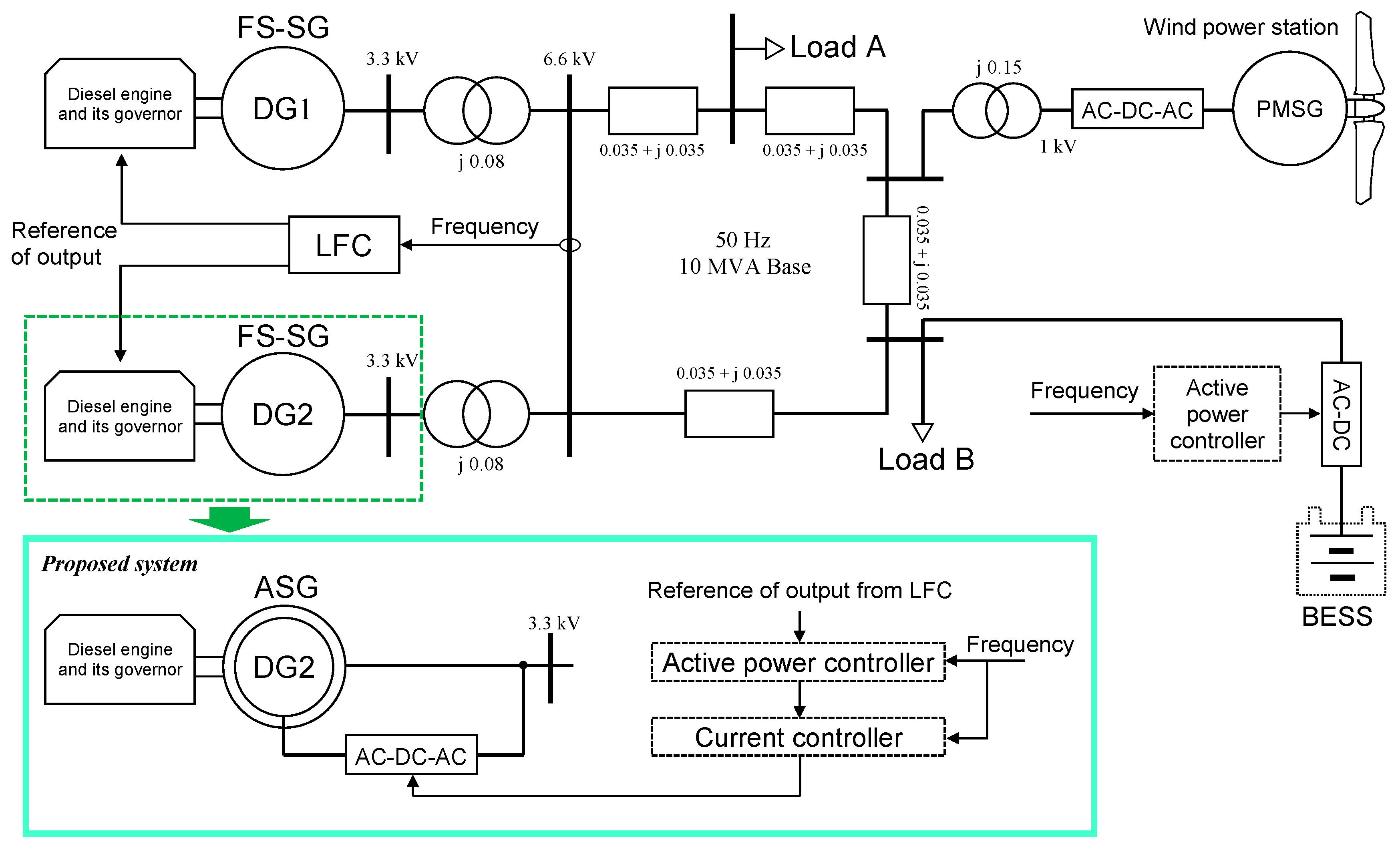

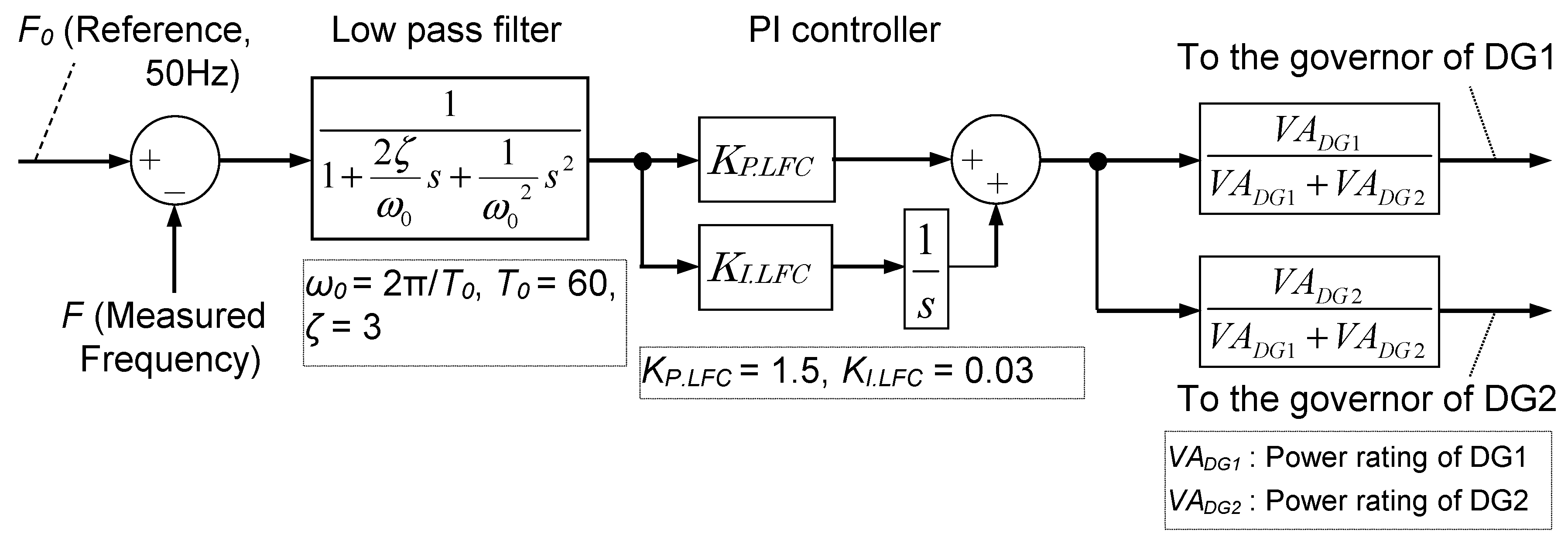

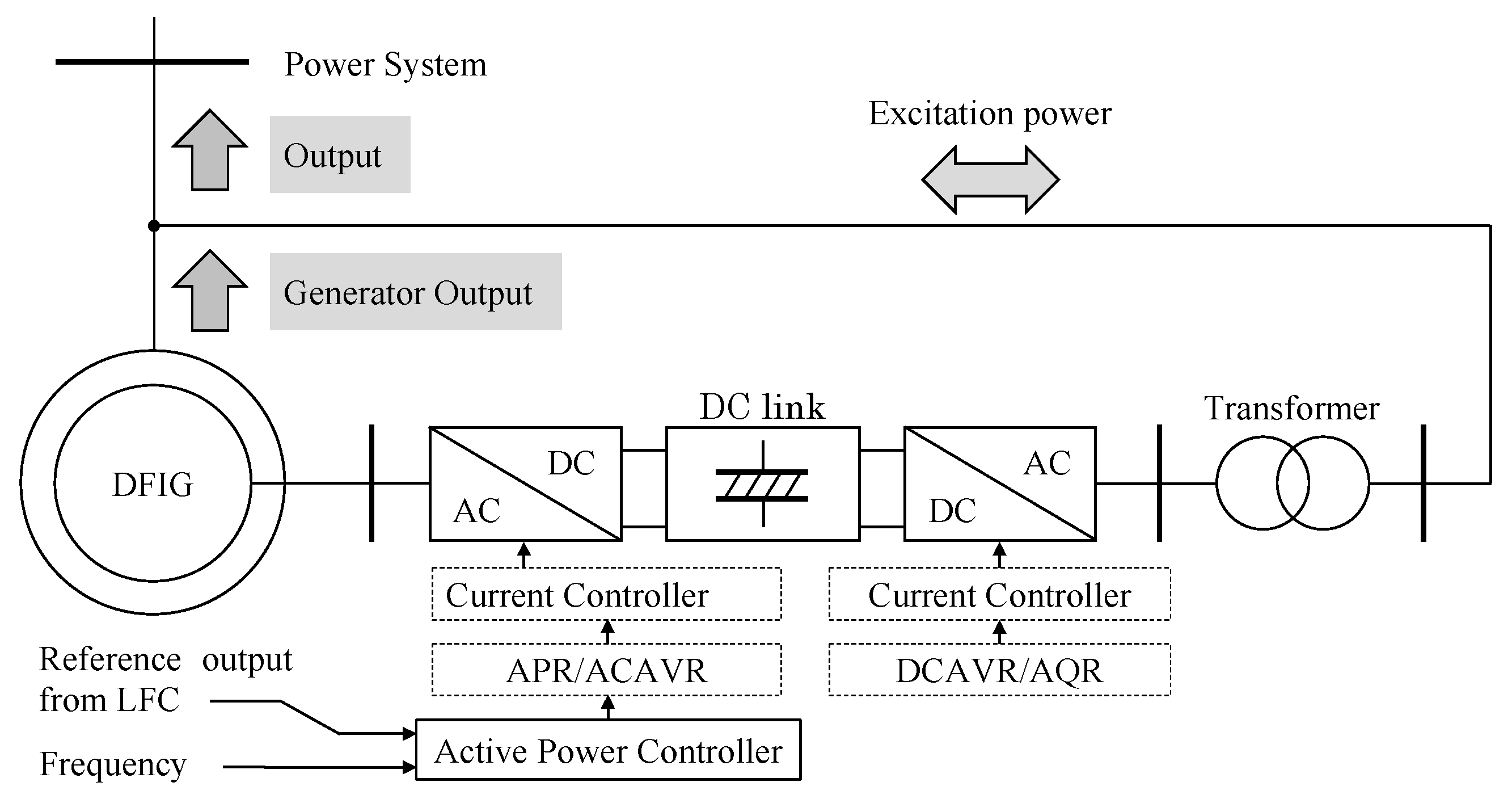


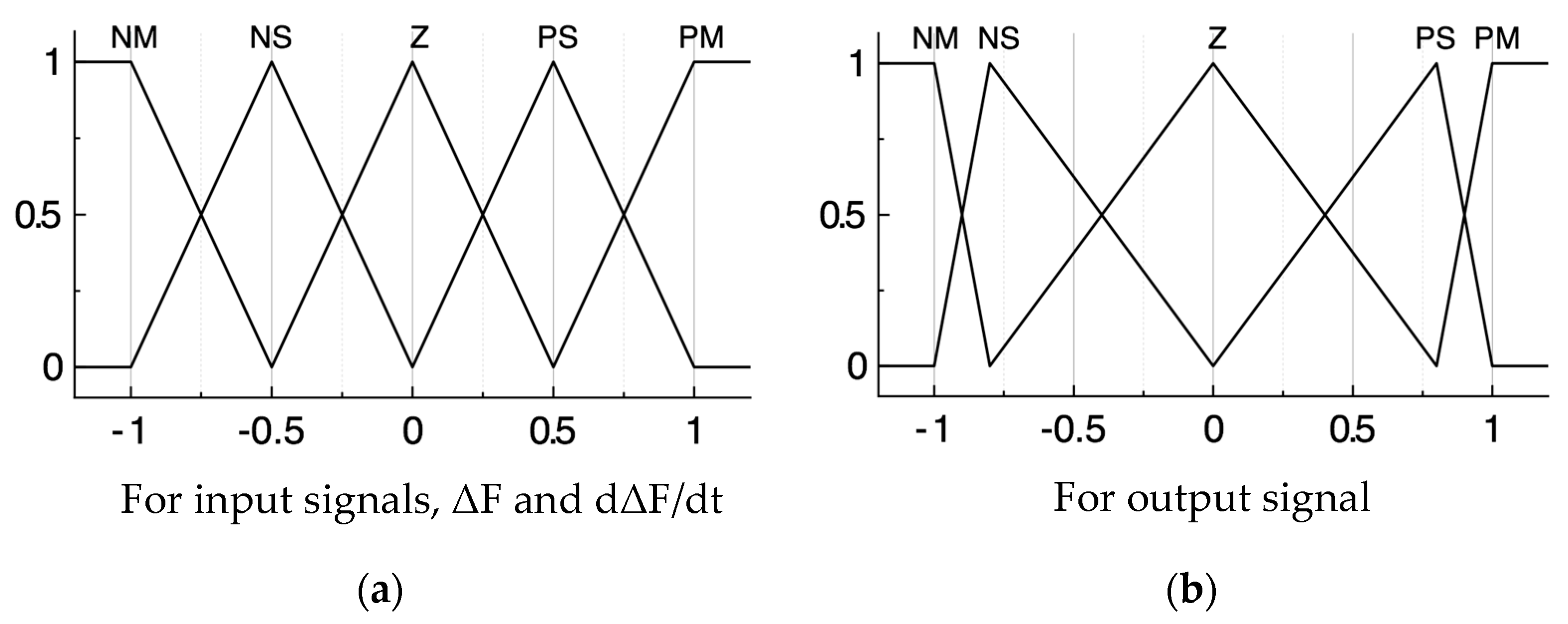




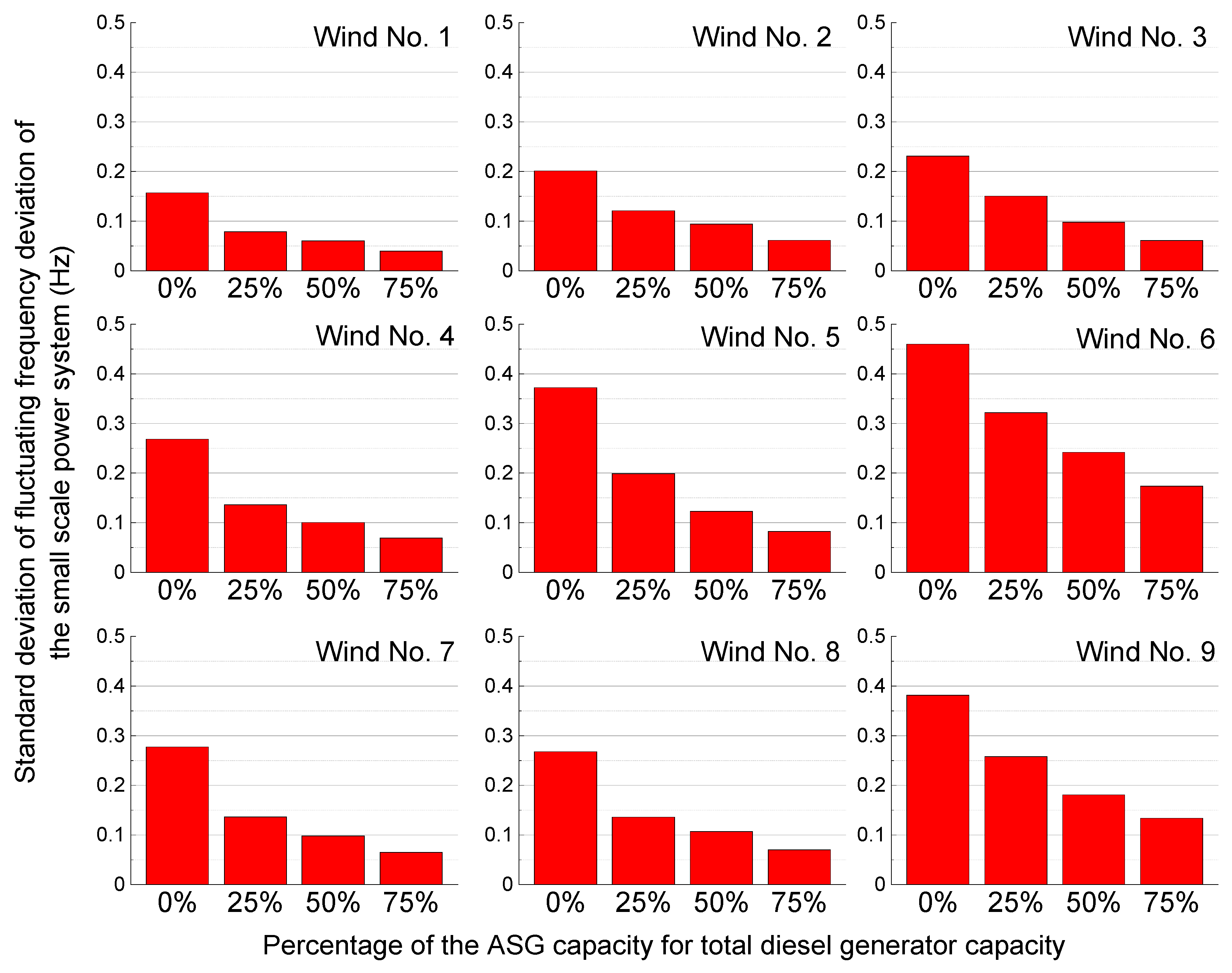

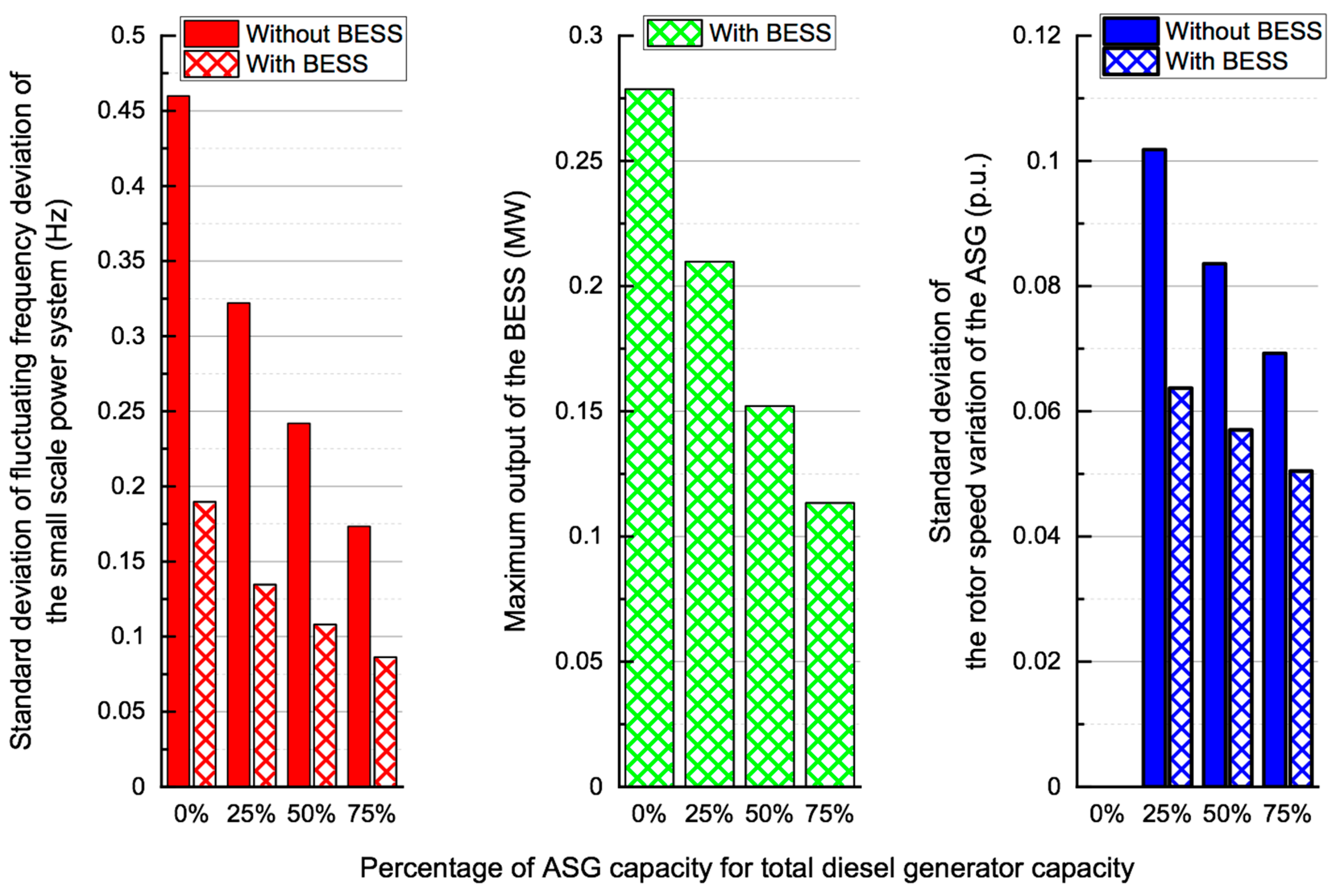
| Main Power Plants | ||||||||
|---|---|---|---|---|---|---|---|---|
| Plant | Generator Type | Rated Capacity (MVA) | Rated Voltage (kV) | Inertia Constant H (s) 1 | ||||
| Case 1 | Case 2 | Case 3 | Case 4 | |||||
| DG1 | FS-SG | 5 | 7.5 | 5 | 2.5 | 3.3 | 2 | |
| DG2 | FS-SG | 5 | - | - | - | |||
| ASG | - | 2.5 | 5 | 7.5 | ||||
| Wind Power Station (Permanent Magnet Synchronous Generator) | ||||||||
| Rated Capacity (MVA) | 0.5 | |||||||
| Rated voltage (kV) | 0.69 (1.0 at the connection point of the power system) | |||||||
| Inertia constant H (s) 1 | 3 | |||||||
| Loads (Common to Load A and B) | ||||||||
| Capacity (MVA) | 3.75 | |||||||
| Power Factor | 1.0 | |||||||
| Parameters | FS-SG (DG1 and 2) | ASG (DG2) |
|---|---|---|
| Time constant of the Transducer TDG (s) | 0.1 | 0.1 |
| Gain of the Transducer GDG (s) | 20 | 20 |
| Proportional gain KP | 0.1 | 0.01 |
| Integral gain KI | 0.0 | 0.0002 |
| Differential gain KD | 0.0 | 0.1 |
| Time constant of the pilot servo TP.DG (s) | 1.0 | 1.0 |
| Time constant of the diesel fuel delay Td.DG (s) | 0.5 | 0.5 |
| Speed reference ωref (pu) | 1.0 | 1.044 |
| Resistance of Stator Winding | 0.0025 pu |
| Leakage reactance of stator winding | 0.14 pu |
| Resistance of field winding | 0.0004 pu |
| Leakage reactance of field winding | 0.2 pu |
| D-axis synchronous reactance | 1.66 pu |
| Q-axis synchronous reactance | 0.91 pu |
| Resistance of Stator Winding | 0.01 p.u. |
| Leakage reactance of stator winding | 0.15 p.u. |
| Magnetizing reactance | 3.5 p.u. |
| Resistance of rotor winding | 0.01 p.u. |
| Leakage reactance of rotor winding | 0.15 p.u. |
| Rated Frequency | 20 Hz |
| Stator winding resistance | 0.02 p.u. |
| Stator leakage reactance | 0.1 p.u. |
| D-axis synchronous reactance | 0.4 p.u. |
| Q-axis synchronous reactance | 0.4 p.u. |
| dΔF/dt | PM | PS | Z | NS | NM | |
|---|---|---|---|---|---|---|
| ΔF | ||||||
| PM | NM | NM | NS | NS | Z | |
| PS | NM | NS | NS | Z | PS | |
| Z | NS | Z | Z | Z | PS | |
| NS | NS | Z | PS | PS | PM | |
| NM | Z | PS | PS | PM | PM | |
| dΔF/dt | PM | PS | Z | NS | NM | |
|---|---|---|---|---|---|---|
| ΔF | ||||||
| PM | NM | NM | NS | NS | Z | |
| PS | NM | NS | NS | Z | PS | |
| Z | NS | Z | Z | Z | PS | |
| NS | NS | Z | PS | PS | PM | |
| NM | Z | PS | PS | PM | PM | |
Publisher’s Note: MDPI stays neutral with regard to jurisdictional claims in published maps and institutional affiliations. |
© 2020 by the authors. Licensee MDPI, Basel, Switzerland. This article is an open access article distributed under the terms and conditions of the Creative Commons Attribution (CC BY) license (http://creativecommons.org/licenses/by/4.0/).
Share and Cite
Takahashi, R.; Umemura, A.; Tamura, J. Cooperative Frequency Control of a Small-Scale Power System between Diesel Engine Driven Adjustable Speed Generator and Battery. Appl. Sci. 2020, 10, 9085. https://doi.org/10.3390/app10249085
Takahashi R, Umemura A, Tamura J. Cooperative Frequency Control of a Small-Scale Power System between Diesel Engine Driven Adjustable Speed Generator and Battery. Applied Sciences. 2020; 10(24):9085. https://doi.org/10.3390/app10249085
Chicago/Turabian StyleTakahashi, Rion, Atsushi Umemura, and Junji Tamura. 2020. "Cooperative Frequency Control of a Small-Scale Power System between Diesel Engine Driven Adjustable Speed Generator and Battery" Applied Sciences 10, no. 24: 9085. https://doi.org/10.3390/app10249085





